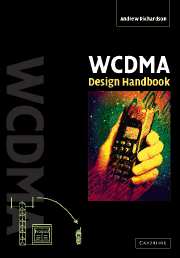Book contents
- Frontmatter
- Dedication
- Contents
- Preface
- Acknowledgements
- List of abbreviations
- 1 Introduction
- 2 WCDMA in a nutshell
- 3 Spreading codes and modulation
- 4 Physical layer
- 5 RF aspects
- 6 Chip rate processing functions
- 7 Symbol rate processing functions
- 8 Layer 2 - medium access control (MAC)
- 9 Layer 2 - RLC
- 10 PDCP and BMC protocols
- 11 Layer 3 - RRC
- 12 Measurements
- 13 NAS
- 14 Idle mode functions
- Appendix
- References
- Index
4 - Physical layer
Published online by Cambridge University Press: 05 October 2013
- Frontmatter
- Dedication
- Contents
- Preface
- Acknowledgements
- List of abbreviations
- 1 Introduction
- 2 WCDMA in a nutshell
- 3 Spreading codes and modulation
- 4 Physical layer
- 5 RF aspects
- 6 Chip rate processing functions
- 7 Symbol rate processing functions
- 8 Layer 2 - medium access control (MAC)
- 9 Layer 2 - RLC
- 10 PDCP and BMC protocols
- 11 Layer 3 - RRC
- 12 Measurements
- 13 NAS
- 14 Idle mode functions
- Appendix
- References
- Index
Summary
Introduction
In this chapter, we see how the specific spreading and scrambling codes are created for the WCDMA system, and how the physical channels are structured. We start by considering the physical channels defined for the uplink and then the physical channels defined for the downlink.
Physical channel mapping
Figure 4.1 illustrates the mapping between the transport channels and the physical channels. The figure shows which transport and physical channels exist in both the uplink and the downlink, and also whether or not these channels are bi-directional or single-directional.
Some of the physical channels are used only by the physical layer, and have no transport channel associated with them. In the sections that follow, we consider some of the physical channels in greater detail.
Uplink channels
Physical random access channel (PRACH)
The PRACH transports the RACH transport channel across the radio interface. As the name implies, the PRACH uses a random access process based on a modified form of the slotted aloha protocol [9].
The PRACH consists of the transmission of an access preamble in a specific part of an access frame, as shown in Figure 4.2. If a positive acknowledgement is received on the acquisition indication channel (AICH), then the UE can proceed to transmit what is known as the message part.
- Type
- Chapter
- Information
- WCDMA Design Handbook , pp. 115 - 136Publisher: Cambridge University PressPrint publication year: 2005



